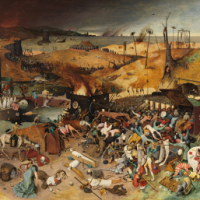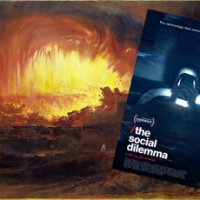Okay, what now? – Thoughts in the Aftermath of Students Submitting AI Generated Work
“To be ‘against technology’ makes no more sense than to be ‘against food.’ We can’t live without either. But to observe that it is dangerous to eat too much food, or to eat food that has no nutritional value, is not to be ‘antifood.’ It is to suggest what may be the uses of food.” – Neil Postman
No matter how much you expect it to happen, there is still something deeply frustrating about the moment you realize you are grading a paper that was created using ChatGPT.
I knew it was probably bound to happen eventually, nevertheless, in the moment that I realized what was happening, I found myself going through the five stages of grief in a span of seconds. At first, I genuinely could not believe it, surely, I had to be mistaken and there was another explanation. Next, I was overcome by anger, frustrated with all of those responsible and with myself for not doing more to avoid this situation. Once my anger subsided, I simply felt sad and disappointed, distraught at the sense that this was now to be my lot. Refusing to wallow I began thinking of what I could do next in order to prevent this from happening again as I considered reaching out to friends who had dealt with this themselves. And, in the end, even though I still refused to accept that this was the new normal, I found I had no choice but to accept what had happened.
The specifics aren’t particularly noteworthy. I’m teaching a course that aims to develop students’ speaking skills, and so I had them write a short essay which had them watch a recording of a famous speech, and asked them to provide an analysis of the rhetorical and oratory techniques the speaker used along with their personal response to the speech. It’s not that I was unaware of the existence of programs like ChatGPT, but that I thought the assignment simple enough that no one would need to use it—and I had hoped that the assignment’s focus on personal perspective would push students to give their own accounts. I do not claim it was a perfect assignment, or the most creative one I have ever developed, but it was a short and simple one that asked students to draw on what we had learned thus far in the semester and apply it. And, as far as an underlying justification for the assignment, I believe that being able to recognize and comment on the techniques a speaker is using to persuade their audience is a genuinely valuable skill.
As for what happened, the story itself is remarkable only in its utter predictability. I began grading an essay that made use of some very specific and curious terminology. Descriptors for particular oratory techniques that had not come up in our class discussions, or any of our assigned readings. I shrugged it off at first, figuring this student must have studied Latin or participated in debate club. But then, a couple of papers later, I found those words used again—alongside identical examples and quotes. And then I saw it happen again. And then I saw it happen again and again and…well you get the picture. Once is a fluke, twice is a coincidence, but at a certain point it’s impossible to ignore a clear pattern. And so then, with a certain degree of nausea, I logged into ChatGPT, entered a simplified version of the assignment prompt into the program, and sat back and watched as the program pretty much generated the essays I had just read. To be clear, it was not that what ChatGPT generated and what my students turned in was identical, but looking at that output the source of the odd terminology those students had used suddenly became clear.
I have lost count of how many workshops and meetings I’ve been made to attend on the topic of generative AI in the classroom, and I will openly admit that I am quite skeptical of the grandiose claims currently being made by the AI faithful. To put it clearly: I think many of the current claims about AI are bullshit, and I think there are a lot of academics who should know better but who are getting wrapped up in technologically deterministic narratives about AI. And, to be clear after grading a stack of papers, some of which were clearly written using generative AI, I continue to believe that many of the current claims about AI are bullshit, and that my colleagues who are falling for technologically deterministic narratives around AI should know better.
Nevertheless, no matter what you think about AI generated work, there is something different about opining on it abstractly and that moment when you find yourself looking at such work that was submitted by one of your students. And thus, at risk of just contributing to the glut of writing about AI, here are some things that I learned from the experience.
*
The AI generated essays students are turning in are not just copy and pasted from the AI program
Based on the way generative AI is often discussed, it seems as if the assumption is that a student simply enters their prompt, maybe offers a couple of simple iterative tweaks, copies and pastes it into a new document, and then submits that paper to their unsuspecting instructor. An instructor who in these discussions is framed as someone with no experience reading/grading student work, and therefore completely unable to recognize that there is something off about the sterile robotic prose of generative AI. But this is not the reality of the classroom. Most students know better than to simply copy and paste the work and hit submit, and what’s more most students know that their instructor has experience with student work (and that, quite possibly, due to other sorts of assignments the professor might already have a sense of how a student writes).
There are certainly students using generative AI to write their papers entirely, but based on my experience it seems that many more students are using generative AI a bit more subtly to outline their papers, using it to help identify the arguments to make in their papers, or using it to give them content that they can then tweak. Or, to put it differently, generative AI gives the student a paragraph, and then the student rewrites that paragraph in their own style. This can be a pretty effective way to disguise the use of generative AI, and it seems that students are aware of it—after all, many of them know that their classes (and universities) may have policies against using generative AI, so if they’re going to use it, they need to cover their tracks.
All of which is to say that the essay generated using AI, may not at first glance obviously look like an essay that was generated using AI.
The telltale signs of the use of generative AI emerge not quite as much in a single essay, but instead over the course of all the essay submissions. Even before the current AI mess, graders were usually on the lookout for papers that seemed a little too eerily similar to one another—and those uncanny similarities are the real clues that generative AI is being used. Five years ago if ten students submitted nearly identical papers, the instructor would probably ask to have a word with those students; and today when ten students submit nearly identical papers, the instructor will still probably want to have a word with those students. Granted, today, that instructor might have a pretty good idea of exactly what has happened (especially if they tested the assignment prompt in generative AI themselves).
This matter will likely only grow more complicated over time. Students will likely get better at using these programs, even as instructors get more attuned to recognizing the output of these programs. But, at base, it is a mistake to think that students are just copying and pasting.
That they are using it does not mean that they know how to use it well
Several weeks ago, I attended a meeting at which student use of generative AI tools was discussed. Two of the main speakers at the meeting were a couple of AI experts, who provided attendees with a lengthy demo of some of the capabilities of some of the programs in question. Sitting there that day, I watched as those AI experts took a fairly straightforward assignment prompt and then iteratively refined their response over and over and over and over and over again. Taking each block of generated text and telling the program exactly how to refine it so that the output would not look obviously like something churned out by a chatbot.
In fairness to this couple of AI experts, they were doing all of this iteration in the span of about five minutes (there were other things to cover), nevertheless, at the time I was struck by a few things: even after all that iteration the final product was still remarkably bland and overly general, and more importantly I was doubtful most students knew all of the iterative tricks that these AI experts were employing.
My encounters thus far (relatively limited though they may be) with students relying on these tools, bear out those suspicions I had while watching that demonstration. At the start of the hubbub around generative AI, I recall seeing some academics joking that they’d be able to identify AI related papers because students would be turning in immaculate text with sparkling prose. But that isn’t what tipped me off. The cue for me wasn’t freshman papers being written at a graduate student level, what tipped me off was how completely devoid of the beautiful chaos of student writing these papers were. It wasn’t that the offending papers were too good to be true, it’s that the offending papers were too ordinary to be true. Indeed, perhaps that is the real danger, not that these papers are designed to earn an A+, but that they’re designed to sneak by with a B-. Honestly, had only one student used it, I probably would have missed it. But when you see several papers using the exact same language, exact same quotes, exact same structure, and the exact same terms that were not discussed in class—something is clearly up. And, to say it again, what stood out was not the level of quality, but its complete lack.
At the aforementioned meeting, the AI experts had acknowledged that much of what generative AI churns out is fairly bland. Which is why they had emphasized that the key thing is to use lots of additional iterative prompts to gradually improve that content. And the student work I saw suggested that many of them did not understand the need for this second step, or, to put it slightly differently, that they were overwhelmed college students and not bonafide AI experts who knew precisely how to subtly shift the prompt along. There is often an assumption that younger generations have a high level of technical skill and that they are able to immediately master any new gadget or program. But I think many an educator has seen how this expectation of younger generations has in actuality meant that nobody is genuinely teaching many of these young people how to use particular gadgets or platforms. Thus, they may be able to learn how to use the basic features decently, but they don’t necessarily know how to do the more advanced stuff.
Perhaps over time these programs will improve, and perhaps over time as students get more accustomed to using these programs the students will gradually learn how to use the programs more effectively—but as of now that students are using these programs doesn’t mean that they really know how to use them well.
Almost as bad as the actual AI generated work is the paranoia it inspires
I had a stack of around sixty essays to grade. I did not realize that something strange was afoot until I had gone through about a sixth of them—at first I flagged the issues to return to later. I was about a third of the way through when I stopped what I was doing to try to figure out this not particularly challenging mystery.
The problematic papers were quite clear and easy to identify. Not because I was relying on one of those programs that scans student text and tells you if it was AI generated or human generated (I do not use such a program). But because after you’ve spent enough time grading student work you develop the ability to recognize obvious issues, especially when that issue looks like numerous students submitting nearly identical work.
But the problem wasn’t just the clearly offending papers. The problem was the wave of paranoia that overcame me and had me going back through all of the non-offending papers, in order to look for any signs that I had previously missed. And it was a problem as I graded the rest of the papers and found myself extra on guard for signs of AI, and less able to simply engage with my students’ work. I saw no evidence that the vast majority of my students used generative AI tools, but I hated how much attention I wound up devoting to looking for any evidence of that sort.
It’s annoying to read a student paper that was clearly using generative AI. It’s even more annoying to have to read each student paper with a suspicion that it might have been created using generative AI.
Anxiety about students using generative AI risks turning every academic department into a police department
At risk of being cliche, I genuinely love to teach. Being in the classroom is great. Getting to discuss important topics with students is thrilling. Helping students develop their skills is rewarding. Being able to share expertise and knowledge makes having that expertise and knowledge actually feel worthwhile. Watching students draw well-informed connections and give voice to their own opinions can be challenging but is ultimately a privilege. I want to be in the classroom because I believe that there is value in education, and because I truly believe that the best way to make students care about a subject (and their own education) is to give them an instructor who genuinely cares about that subject.
As universities try to adjust to the deluge of generative AI tools, there has been a parallel flood of new policies and rules designed to threaten and punish students should they make use of these tools. In many cases, the use of generative AI tools (without express permission by the instructor) has been swiftly slotted into university policies around cheating and plagiarism. Policies which often bear very serious penalties, and a set of ominous policies which—as many instructors know—most students never really understood even before all this AI generated drek. And here instructors find themselves having to play the role of investigator and enforcer.
I know some instructors who have a private policy of sighing and ignoring it when students submit AI generated work. I know some instructors who have a zero-tolerance policy on AI generated work and will give students a 0 on that assignment and a stern warning. I know some instructors who are so worried about I generated work that they have completely re-designed their class to protect against AI generated work being submitted. And I know some instructors who flag AI generated work as plagiarism and report the student to the relevant disciplinary authorities.
I have no interest in being a crime scene investigator. I have no interest in getting students in trouble. The department I work for on campus isn’t the campus police department.
But I worry that generative AI, and the way many universities are reacting to generative AI, is making many instructors feel like they’ve just been handed a badge and a gun that shoots Fs.
Generative AI in the classroom isn’t just about essays
The other day, a few minutes before class started, while I was downloading my slides to the classroom computer, a group of students at a nearby table were immersed in a heated conversation. To put it simply, they were all feeling overwhelmed by a math class that most of them were taking—with some lamenting that they were falling behind on assignments, and others admitting that they had not been doing well in the class. And as they grumbled, one student calmly explained that he wasn’t having any problems. Was this student just a wunderkind, a genius at math, or in possession of excellent time management skills?
No. He wasn’t. As the student calmly explained to his peers, he was using a program to give him the right answers on his homework—and even on his exams. And as I watched, his classmates all hastily set about downloading the program on their phones and computers.
Unable to contain myself (I was standing about three feet away, and obviously in ear shot), I asked the table if their math professor was okay with them using that program. And the nervous laughter I was met with provided me with a very clear answer to my question.
There seems to be a lot of attention to what ChatGPT and similar programs are doing to essay writing, and thus stories about ChatGPT have fit easily into the ever present narratives about the death of the humanities. Indeed, these stories are amped up because ChatGPT seems to be a perfect case of a new technology upending the humanities. However, it’s worth recognizing that these various programs are being used in a lot more than just humanities classrooms. And in a classroom where all a student needs to do is plug in the right answer (and maybe show a bit of the work), an app that gives them the right answer and shows that work will potentially be much harder to detect than in the case of an AI generated essay.
The point here is not to feed academic paranoia, or to turn STEM departments into panopticons—but amidst the conversations about AI in education we shouldn’t pretend that AI programs are only a problem for the humanities.
Bluebooks are going to make a comeback (for better or probably for worse)
In conversation with various professors, I’ve heard a lot of different things that are being done to ensure that students aren’t using generative AI. Some professors are moving away from essays, research papers, and formal assignments in favor of things like podcasts, short videos, or creative presentations. Some professors are shifting the focus of their written assignments to focus less on the restatement of facts and arguments and instead to focus more on asking students to present their own thoughts and feelings about a topic. Some professors are refusing to change anything, standing firmly in their belief that the assignments they’ve been giving for years have meaning, value, and develop important skills—if students want to cheat, it’s their own damn loss. And, of course, there are some professors who are turning back to the humble bluebook.
Yes, the bluebook. That small pamphlet of lined pages with a sky-blue cover. A slim packet the sight of which immediately conjures an overwhelming feeling of “in class writing assignment.” Indeed, many instructors are reacting to their suspicion that take home essays/assignments will just wind up being written using AI, by making it as difficult as possible for students to use generative AI. And therefore, they are going back to giving in-class written assignments, and in-class exams. There’s a pretty clear kind of logic at work here: if you’re worried students might be using ChatGPT for their essays, you just need to make it so that students literally can’t have the program open while they’re working. It’s simple enough to still allow your students to do this as “open book,” you just need to require them to have non-digital versions of the “book” in question. And, of course, the students who need particular accommodations can (and are) still provided with those accommodations.
It’s too early to say how this shift will turn out, or how long it will last. We are currently less than halfway through the first semester to truly be happening beneath the specter of generative AI. I imagine that some professors will decide that they really like going back to bluebooks (bluebooks were pretty standard not that long ago), I imagine that some professors will complain about student handwriting and go back to letting students write stuff on computers out of class, and I imagine that some professors will be frustrated by what happened in the fall semester and will therefore go to bluebooks in the spring in response. And I’m sure that still other professors will try to figure out creative ways around this problem by coming up with new assignment ideas that seem to be “AI proof.”
I’m not sure that bluebooks are the best solution. I imagine the return to bluebooks will make many a student unhappy, will increase many an instructors’ workload, and won’t ultimately result in assignments that are more pedagogically meaningful to the students than an at home essay. Furthermore, I worry that students who have been using computers in their classrooms since they were in middle school will be little prepared for the switch to hastily writing a five-paragraph essay by hand. But the return to bluebooks captures a real challenge many instructors are encountering, where they feel that they need to do something, and where the easiest solution is to return to a way of doing things that was common not that long ago.
I know some instructors who are going back to bluebooks as a statement of principled defiance against AI, and who see it as pedagogically useful to teach students not to be so wholly reliant on computerized solutions to all of their problems. But I know far more instructors who are going back to bluebooks because they don’t want to have to be AI detectives.
This isn’t our mess, but we’re the ones who have to clean it up
Most educators did not ask for generative AI.
This is not to say that educators don’t ask for things. They ask for many things! Better funding, and better infrastructure, more time to prepare and more time to grade, smaller class sizes and more teaching assistance, classroom projectors that actually work and HVAC systems that aren’t always on the fritz. But most educators haven’t asked for high-tech tools that make it easy for students to get around doing the work.
This is not to suggest that educators are resistant to technological change. Indeed, many educators (and educational institutions) are so terrified of being mocked as Luddites that they embrace every new gadget and program with too much enthusiasm and too little skepticism. If anything—at least based on my personal experience—I’d say that educators and educational institutions have a serious technophilic streak, and an eagerness to embrace every shiny new technology that get framed as a straightforward solution. Alas, many an educational institution’s past budgets are littered with numerous investments in whatever the “next big things” in technology have been, only for these investments to ultimately prove to have been wasted—even if somewhere at the school there is still a closet with some broken 3d printers, or other obsolete gadgets, gathering dust.
In the midst of all the discussions around generative AI there has been plenty of discussion around how educators and educational institutions are responding: what they are doing, what they are planning on doing, what signs they are watching for. Often in these accounts—especially in the media—it is common to see some version of a story that features an exhausted educator with a genuine commitment to their students’ success, but who is looking at the output of generative AI and truly wondering what to do. After all, many educators seem to think that resistance is futile, that students will definitely be using these tools, while simultaneously worrying that the output of these tools is poor, even as they worry that they are ill equipped to catch the work created by these programs (with many also being skeptical of the automated tools designed to catch the work created by these programs). And, in fairness, one should not expect someone who has spent the last decade (or even the last year) teaching English or History to suddenly be an expert on how to spot generative AI, or an expert on how to integrate generative AI into their classroom. And to be clear, they should not be expected to be.
The world of edutech, and the world of technology being flung at education, is a world of bullshit. And that is putting it politely. It is a nonstop flood of new gadgets and programs that promise to fix all of education’s (and educators’) problems, provided, of course, that education (and educators) completely reinvent their classrooms so that they are in accord with this or that messianic technology. With many of these vaunted technologies coming from people who clearly have barely any teaching experience of their own. It is a deluge that educators have been thrown into without a life-vest, it is a rapid filled river that educators are told they must stay afloat in and navigate—and though educators have been tossed a broken oar and told “steer,” educators are not the ones who keep opening the floodgates.
All of which is to say that educators are one of the groups currently expected to clean up the messes being created by generative AI, but educators aren’t the ones who created this mess in the first place. This is in keeping with a larger trend when it comes to the gifts bestowed upon us by the tech industry, but it is a point that needs to be stated clearly and emphatically in every discussion of how generative AI is impacting education (and many other fields).
To say it plainly: those who are expected to clean up the messes being created by generative AI are not the ones unleashing generative AI upon the world. This is true in areas beyond the classroom, but it is certainly true of the classroom as well.
Educators are not the ones who bestowed generative AI upon our students. And yet educators are the ones who are now expected to become experts on AI use and AI detection. It has become our responsibility to teach our students how to critically evaluate these tools, even as we urge our students not to use them (and potentially penalize students for using them). This is not in lieu of our previous tasks and responsibilities, but in addition to them. This is not a mess of our making, but yet again we’re the ones expected to mop it up—even though our department’s mop budget keeps getting slashed.
It would be tempting to accuse today’s tech titans of being reincarnations of Victor Frankenstein. But compared to these tech titans, Victor Frankenstein looks like a thoughtful and responsible creator. Which is a comparison some of those tech titans might understand if they had read Frankenstein, but they’d probably just get ChatGPT to give them a summary of it.
Against technological determinism
Whenever a flashy new technology appears, one can expect that there will be plenty of people eagerly singing its praises. The tech industry will once again chortle while patting itself on the back (and patting itself on the bank account). Gullible opinion columnists will devote their weekly wordcount to singing songs of praise as they announce the arrival of the next “revolutionary” thing. Tech publications—even the ones that are usually pretty good—will devote breathless coverage to the new thing, with the reporting walking the line between advertisement and hagiography. The always-ready-to-be-dazzled politicians will salivate at the promise of how this new high-tech gadget will provide the solution for the thorny social/political/economic problems that have not yet proven solvable with a quick high-tech fix. While legions of interested individuals will be drawn into the hubbub to playfully tinker with this new toy and post about their experiences online.
And in the midst of all of this, educators (of all levels) have a particular responsibility to remain personally skeptical and vocally skeptical.
Perhaps one of the most disheartening aspects of all of the generative AI hoopla has been watching so many educators who should know better than to fall for the hype, completely falling for it. The titans of tech have announced that AI will sweep across society, upending everything, and a lot of educators have been quick to believe them. As the semester began (and as the semester continues), many an educator (at many an institution) has attended numerous workshops on the dangers posed by generative AI, many an educator (at many an institution) has become inundated with emails warning about this or that new AI program, and many an educator (at many an institution) has received the conflicting commands that they must simultaneously figure out a way to AI proof their classroom while ensuring that they are effectively integrating AI into their classroom so that their students (and their institution) will be leaders in the world of AI. It’s a lot. And it has that mixture of hyperbolic excitement with just a few dashes of apocalypticism which makes it so intoxicating. Yet educators, especially those actually in classrooms with actual students, should be raising a disbelieving eyebrow and pushing back on these deterministic narratives.
The reason why educators should remain skeptical is not because educators aren’t seeing generative AI in their classrooms, it is specifically because educators are seeing generative AI in their classrooms. And they can therefore already see the gulf between the hype around these AI tools and what they actually look like.
To act as though generative AI does not exist would be foolish. To suggest generative AI is not cropping up in the classroom is naïve. But there is a world of difference between the hyperbole around generative AI in the classroom and the reality of what that generative AI actually looks like. What’s more, buying into the utopian/dystopian hype-filled narratives being churned out by those with AI products to sell, just advances the AI celebrants’ narratives rather than puncture them. Many of the most powerful takedowns of AI don’t consist of impassioned defenses of the humanities and the human creative spirit, they look more like observing AI generated output and being willing to say “this is bad, not necessarily ethically bad, this output is just bad.” To be frank, generative AI in the classroom doesn’t look like the most brilliant essay you’ve ever seen that makes you want to tell a student that they should pursue a PhD in the field; no, it looks like a startlingly banal regurgitation of generalities turned in at the last minute by a student who is trying to recover from a “mysterious flu” while taking a full course load, working part-time, caring for a family member, trying to apply for internships, and (maybe) trying to have a social life.
Educators who are trained in historical analysis, in critical engagement with sources, and with the skills to critically read, should be the ones most skeptical of the claims being made by those hawking AI tools. After all, the sorts of training many educators have received should make them especially attuned to smelling the bullshit wafting off of these generative AI tools, and which can be detected beneath the thick cologne of those selling these tools. And if nothing else, basic experience should be enough to remind educators that this isn’t the first time they’ve been warned about how this or that new technology will destroy education, only for it to turn out that the actual reality was far less exciting. This is not to say that new technologies haven’t impacted classrooms, they obviously have, but that doesn’t mean their impact on classrooms has looked (or unfolded) the way that those celebrating these technologies promised.
It is wise for educators to pay attention to the discussions taking place around AI, but the best way for educators to participate in conversations around AI is for them to refuse to participate in the technologically deterministic hype.
That hype doesn’t benefit our teaching, and it doesn’t benefit our students, it only benefits the people cashing in on that hype.
*
The above observations are offered in the fall of 2023, and it is impossible to know for certain what the future of generative AI in classrooms will look like. Nevertheless, if history is any guide, the reality will likely be far more banal than what is currently being promised by the merchants of hope and hype.
Granted, even knowing that, there is still something very disheartening about the moment when you find yourself reading a paper that was created using AI.











